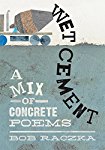Concrete poems, or poems that are laid out on a page to create pictures, are such fun to explore; and to write. Poets who like to write such poems are wonderfully creative and they often inject their writings with a sense of fun as well. Today's title is full of these poems, and readers of all age will enjoy reading and looking at them.
Wet Cement: A mix of Concrete poems
Wet Cement: A mix of Concrete poems
Poetry Book
For ages 7 to 10
Roaring Brook Press, 2016, 978-1-62672-236-1
For Bob Raczka, poems are “word paintings” because the
words on the page “paint pictures inside your head.” The wonderful thing about
concrete poems, or shape poems, is that the words also “paint pictures on the
page.” The words are arranged in such a way that they create an image of something
that represents what the poem is about. For example, for a poem about a candle,
the words might we arranged on the page to look like a flame.
In this
collection of poems Bob Raczka has decided to take the picture-making aspect of
his creations to another level. The words of the poems create a picture, and in
addition the letters in the titles of the poems also create a picture.
For example, in
the poem Crossword, the letters in
the title of the poem are arranged in such a way to create a cross. Then the
words of the poem are placed on the page in such a way that they create what
looks like a crossword.
In the Poem Dominoes, the title letters are tipped to one side, and the words of
the poem look like a row of dominoes that have also been tipped over. The text
in the poem is written from the point of view of the dominoes themselves. They
talk about the need to “brace yourself,” “forward march” and “do your part,” as
they fall over and lean against each other.
The poem Icicles is beautifully picture rich.
Both the letters in the title and the words in the poem hang down like icicles
from the eves of a building. The title is upside down and the lines of the poem
hang sideways so that we have to turn the page to read them. They tell us how
icicles form and how you can “Break one off and take a lick” when the icicles
are “long and clear and ripe.”
Children are
going to be delighted when they see how the poems in this book loop and hop,
circle, crisscross, and hang on the pages to create pictures. They may even be
inspired to try creating concrete poems of their own.

No comments:
Post a Comment